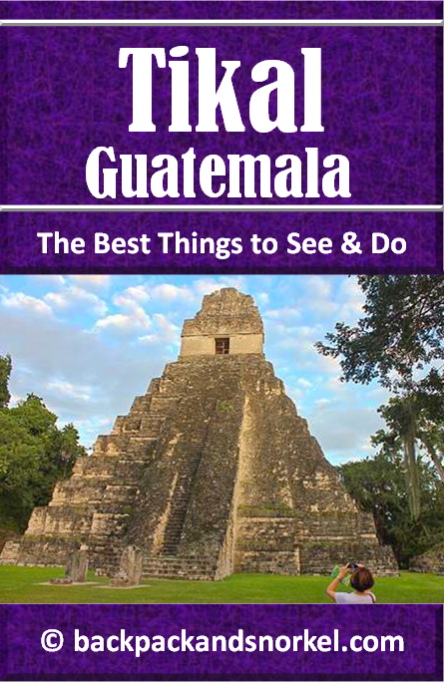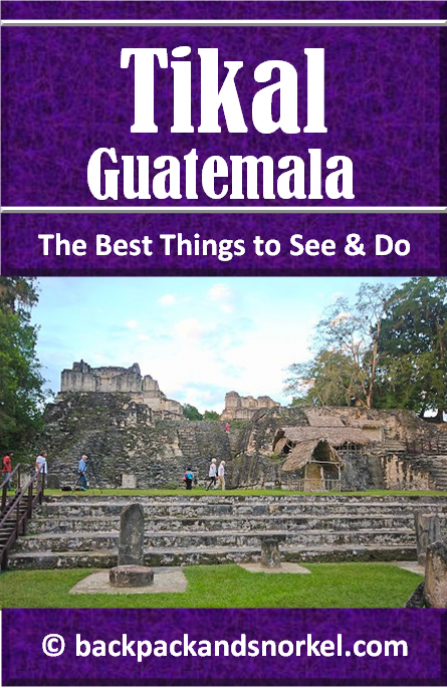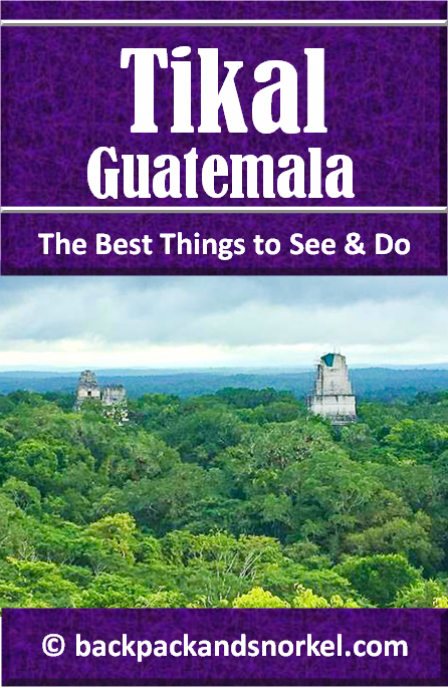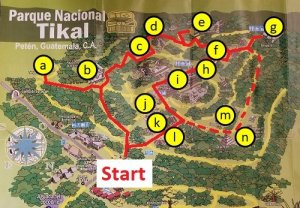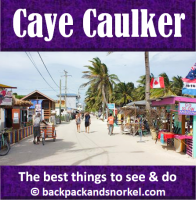CENTRAL PLAZA IN TIKAL (GREAT PLAZA) - Tikal Purple Travel Guide
The Great Plaza forms the center of Tikal and is the place that you should visit first. We tell you what you can see here and we have lots of background information and photos so you understand what you will see.
The plaza is bordered by:
North Acropolis to the north |
Temple II to the west |
Central Acropolis to the south |
Temple I to the east. |
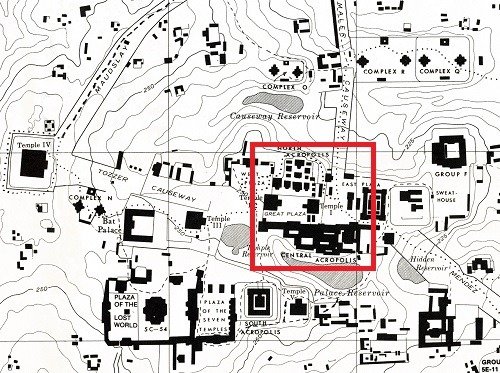

To get here from the parking lot, follow the signs to Templo I – Gran Jaguar. This is about a 20-25min walk.
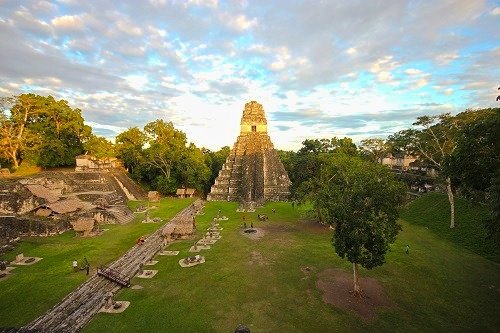
TEMPLE I
This steep pyramid is also known as Temple of Ah Cacao or Temple of the Great Jaguar. The name comes from a giant sculpture of the enthroned king Jasaw Chan K'awil sitting on a jaguar throne on top the temple which has mostly weathered away.
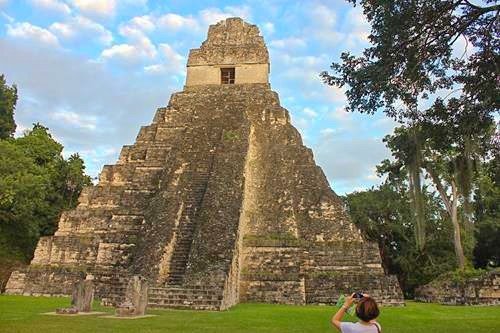
The pyramid is 180ft (55m) tall and was built as a funerary pyramid in which Jasaw Chan K'awil was entombed in 734AD. Construction finished after the king’s death sometime between 740-750AD.
The burial chamber is located inside the pyramid below the level of the Central Plaza. Inside the burial chamber, the king's body was laid on a woven mat on top of a masonry bench. The tomb contained jaguar skins, a necklace with 114 large beads which weighs 8.6lbs (3.9kg), jadeite objects, painted ceramics, rare shells, pearls, mirrors, 37 carved human bones bearing inscribed with hieroglyphs.
The shrine at the top of the pyramid has three chambers. The doorways connecting the chambers were spanned by wooden lintels carved from sapodilla wood. Two were removed and disappeared and the other two were given to the British Museum in London.
Back to the Self-Guided Walking Tour of Tikal
TEMPLE II
Temple II is also known as “Temple of the Mask”. King Jasaw Chan K'awiil I built it in honor of his wife Lady Kalajuun Une' Mo' (=Twelve Macaw Tails) around 700AD. It is 125ft (38m) tall, but it is believed that it used to be 42m tall when it was built due to the original roof comb. No tomb of Lady Kalajuun Une' Mo' has been discovered so far.

The base of the pyramid measures 123ft x 135ft (37.6m x 41m) and the main stairway is 34ft (10.4m) wide.
Flanking the stairway at the upper platform are two badly eroded grotesque masks give this temple the name Temple of the Masks.
Before the shrine on top is a large masonry block that was built into the stairway. It may have served as a platform so that the priests could see the crowd and could be seen.
The shrine itself has 3 rooms and the connecting doorways were spanned by wooden lintels of which one is now in the American Museum of Natural History in New York City.
Temple II is the best restored of all pyramids at Tikal. There is a walkway that allows you to get up for beautiful views and for a fantastic view of Temple I that seemingly starts to glow during sunset.
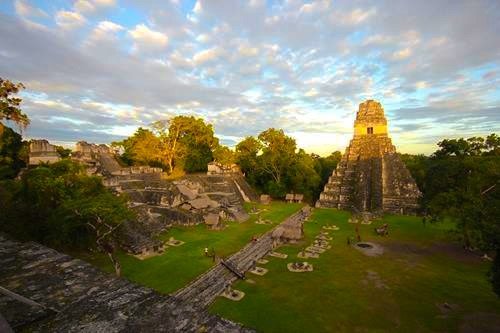

Back to the Self-Guided Walking Tour of Tikal
CENTRAL ACROPOLIS
This architectural complex was used to house Tikal’s royal families. It was established when Tikal was build and occupied until the city was abandoned.
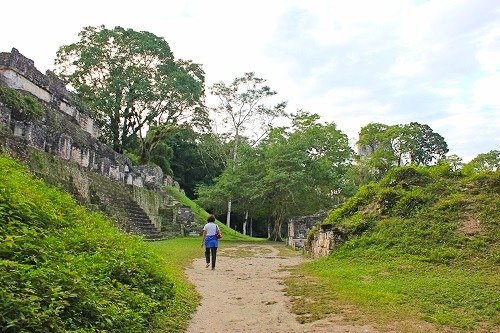
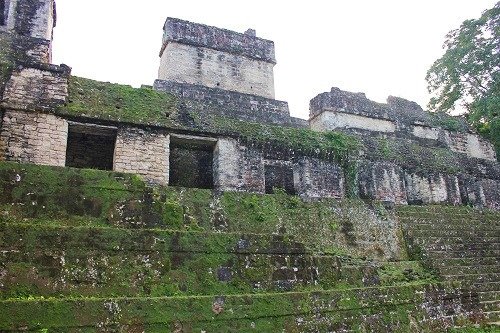
The first structures were built from 350BC to 1AD and consisted of masonry platforms with likely wooden structures on them. Postholes can still be seen here. The platforms were built on the natural bedrock which was leveled above Central Plaza and oriented east-west.
The masonry palace that was later built between 250 and 550AD appears to have been built on top of the earlier platforms. The circumference stayed the same and was not widened.
The 43 palace structures are arranged around six courtyards which were built at different levels.
Lowland Maya sites of that time typically had burials under family residences, but excavations of the Central Acropolis uncovered only a few burials with the exception of structure 5D-46 where four burials were discovered. This indicated that the structures of the Central Acropolis were likely not permanently occupied residences and may have served as temporary residences for priests or schools.
Notable structures are:

Structure 5D-46
Built around 350AD, this opulent and complex single story structure was likely the residence of the royal family. Hieroglyphic inscriptions show that it was residence of king Chak Tok Ich'aak I who ruled from ca. 360AD until he was killed in 378AD.
It was built on a raised platform with stairways on the east and west of the building.Structure 5D-52
This structure, which faces south, was built over an earlier structure that faced north. The earlier structure is called the Palace of the Red Dado. The name comes from a band of red decoration that was painted along the base of the interior walls. Even though the upper portions were destroyed for the construction of 5D-52, the lower walls were well preserved.Structure 5D-65
This structure is called Maler's Palace after Teobert Maler who came here in 1895 and 1904 to help the excavation, hung a “Mi Casa” sign on this structure and made it his abode during those times. The room in the western part of the structure has an exterior doorway and a large recessed false doorway opposite the exterior door, which gives the illusion of this being a temple when viewed from below.Structure 5D-71
This structure that faces north onto the Great Plaza is built on an early masonry platform that was built between 350 BC and 1 AD. It is located on the sacred axis that runs through the North Acropolis. Originally built with stairs from Central Plaza and stairs from the east, the stairs to courtyard 1 (to the south) were built later. Burial 177 was found under courtyard 1 precisely on the sacred axis, which means that this person was likely an important person in Tikal.
Back to the Self-Guided Walking Tour of Tikal
NORTH ACROPOLIS
This architectural complex was a cemetery for over 1300 years. It measures 330ft x 260ft (100m x 80m), covers 2.5 acres (1ha), stands 39ft (12m) above the Great Plaza and 30ft (9m) above its bedrock foundation.
There are several stairways that lead up to the North Acropolis from the Great Plaza.

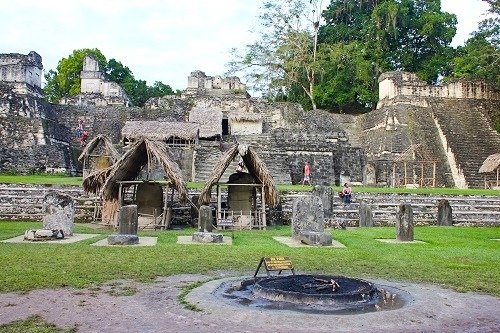
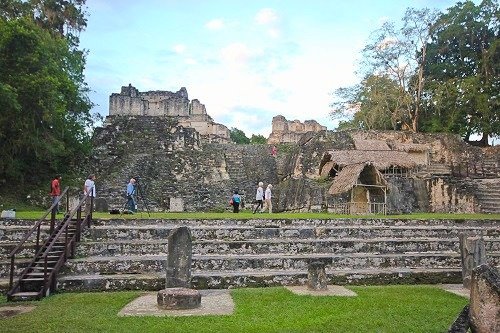
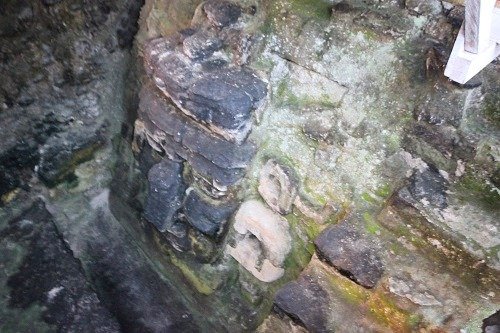
First activity was traced back to 800BC and the first structures were built in 350BC.
At some time during 350BC and 250AD, a 161ft (49m) wide causeway was built to connect the North Acropolis with the Mundo Perdido complex to the southwest.
At around 250AD, the complex underwent major reconstruction and began to be used as a royal cemetery and new structural were built over older ones.
At 400AD, the cemetery was expanded to its current size and in 450AD a row of four pyramids was added obstructing the view from the Central Plaza.
At the end of the 7th century, Temple 33 was rebuilt and the new version closed off the entrance to the North Acropolis. This ended the tradition to bury kings here and in 734 CE king Jasaw Chan K'awiil chose to be entombed in Temple I instead.
Burials at North Acropolis continued for the next several hundred years. Before Tikal was abandoned in 10th or 11th century, grave robbers looted several of the graves.
Structures of North Acropolis:

Source: Harrison, Peter D., The Central Acropolis of Tikal, map prepared by Amalia Kenward; The Central Acropolis of Tikal - in Sabloff, Jeremy A. "Tikal: Dynasties, Foreigners, & Affairs of State" ps. 171-206
Temple 20 (Structure 5D-20)
Built around 550AD; faces northTemple 21 (Structure 5D-21)
Built around 550AD; faces northTemple 22 (Structure 5D-22)
South facing Temple 22 underwent three construction phases – most other temples in the North Acropolis only had one or two. The earliest temple here was built around 250 CE. The second, which was decorated with giant stucco masks, around 350 CE and the third version in the 5th century. Archaeologists removed some parts of the third construction phase to expose earlier versions of the temple.
Burial 200 was the tomb of king Wak Chan K'awiil who ruled from 537?–562AD. The tomb was looted at some time after Tikal fell.Temple 23 (Structure 5D-23)
This east facing temple was built at around 250AD and has been partially restored.Temple 24 (Structure 5D-24)
Built roughly at the same time as Temple 23, this yet to be explored temple appears to be the mirror image of Temple 23.Temple 25 (Structure 5D-25)
This south facing temple was first built around 250AD. The second construction phase completely covered the earlier temple.Temple 26 (Structure 5D-26)
This structure is the central building of the North Acropolis. It was first built around 250ADand its tomb was looted after the fall of Tikal. It has been fully excavated and restored.
Burial 85 took place here at around 100AD and was the first royal burial here. This marked the shift from burials at the Mundo Perdido complex to the North Acropolis. The tomb is located on the north-south axis of the North Acropolis over which Temple 26 would later be built. It contained one male skeleton, which lacked a skull and thighbones. Archeologists believe that this man probably died in battle and that his body was mutilated by his enemies before his followers recovered his body and buried it here. The bones were wrapped in textiles and the missing head was replaced by a greenstone mask with had shell-inlaid teeth and eyes and which wore a three-pointed royal headband.Temple 27 (Structure 5D-27)
This temple appears to be the mirror image of Temple 25 and was built the same time as Temple 25.Building 28 (Structure 5D-28)
This building was likely built in the early 6th century AD and may have been a guardroom which controlled access to the site from the east terrace. It completely blocked access from the stairway and forced visitors to walk this building. After Temple 33 completely blocked the main access stairway from the Great Plaza, this passage may have been the only way to access this part of the North Acropolis.Temples 29, 30 and 31
Not much is known about these 3 temples as they have not yet been excavated. It is believed that they were built between 250-350AD. Traces of red paint were found only on Temple 29. All three temples are 7.5ft (2.3m) tall.Temple 32 (Structure 5D-32)
Built between 600-650AD, this south facing temple contains three large chambers, which were looted soon after Tikal was abandoned in the 10th century. Under the pyramid is a tomb, which was cut into the bedrock. It contained a royal Burial 195. The pyramid that you see today was built over the tomb shortly after the king's burial. Unlike other pyramids here, this temple was built in a single construction phase.
The tomb was for a king of unknown name who archeologists call "Animal Skull". The remains of the king were wrapped in cloth that was dyed red. It appears that the tomb flooded soon after it was sealed. A thick layer of mud that eventually dried preserved the shapes the king's burial offerings even after they rotted away. Archaeologists filled these hollow structures with plaster which helped them to reconstruct many of the perishable items that were buried together with the king. Other artifacts that were found here were: four large carved panels showing the king, a throne with hieroglyphs on it, four stucco figurines of the deity K'awiil and a ballgame yoke.Temple 33 (Structure 5D-33)
This 33m tall (108ft) south facing temple is the funeral pyramid of king Siyaj Chan K'awiil II who ruled from 411–456 (Burial 48). Like Temple 22, it underwent three construction phases with the last one taking place during the Tikal Hiatus between 562 and 692AD.
Interestingly, the last construction phase of was actually used as a prototype for the construction of Temple I on the Great Plaza. If you find that Temple 33 and Temple I do not look like each other at all, don't be surprised. In a very controversial decision, the final version of Temple 33 was dismantled by archaeologists in 1965 in a move to understand how the earlier versions of this temple looked like.
Burial 48, the original burial here, was carved into the bedrock under the terrace right on the north-south axis of the North Acropolis. As mentioned, this is the tomb of king Siyaj Chan K'awiil II. The king was in a seated position with his skull, hands, and femurs missing. Beside him were remains of two juvenile human sacrifices - one was a child and the other an adolescent.
The walls of the tomb were coated with stucco with hieroglyphs painted on them indicating that the tomb was sealed in March 457, which was one year after the king died.
The tomb contained 27 ceramic vessels, stone, jade and shell artefacts, including jade discs and hundreds of beads (some likely from a semicircular collar that decomposed, others not associated with the collar), two pairs of earspools and two obsidian blades.
Burial 23 was a royal tomb that was cut into the bedrock under the temple by destroying the second version of the access stairway of Temple 33. The person interred here has not been identified but it is believed that the late 7th-century king Nuun Ujol Chaak could be interred either here or in Temple 35.
Whichever king was buried here, it appears to have been a hastily organized interment. Plaster from the walls was found to be splashed on some of the grave goods and even a flint pick that a worker must have accidentally left behind was found.
The body of the king was laid out on jaguar pelts and covered in layers of marine shells.
Burial 24 was an elite status burial inserted into the rubble core of Temple 33 during the final phase of the pyramid's construction. Archeologists found painted ceramic dishes that appear to name Nuun Ujol Chaak's father and grandfather.Temple 34 (Structure 5D-34)
This was the first pyramid that was built on the front terrace of the North Acropolis, likely between 404-450AD by king Siyaj Chan K'awiil II over the tomb of his father Yax Nuun Ayiin I (Burial 10).
When archeologists cut a trench through the temple base, they discovered the tomb and that the temple was built 3 construction phases.
The Burial 10 tomb contained the remains of the king (with his skull dyed red), nine human sacrifices, a headless caiman and lots of ceramic vessels (many decorated with Teotihuacan imagery), a ceramic drinking vessel (with the writing "the drinking vessel of the son of Spearthrower Owl"), five turtle shells which were parts of a musical instrument, and a small jade ornament (sculpted like a caiman's head with a curled snout). It is important to note that the king's name contained the word “Ayiin” which means "crocodile".
On top of the pyramid is a shrine with three rooms situated one behind the other. In this shrine was a masonry altar under which monument (Stela 26) was discovered. Stela 26 originally stood at the foot of Temple 34, but it was broken and then brought up into the shrine.
Stela 4 and Stela 18 are two monuments from the reign of king Yax Nuun Ayiin I that were re-erected at the base of his funeral pyramid. They show deities from Mayan and Teotihuacan cultures. Stela 4 shows the king with the Underworld Jaguar God under one arm and the Mexican Tlaloc (supreme god of the rain) under the other. His helmet shows a simplified version of the Teotihuacan War Serpent. Common in Teotihuacan sculptures, but unusual for Mayan sculptures, he is shown with a frontal face and not from the side.Temple 35 (Structure 5D-35)
This unexcavated temple facing south towards the Great Plaza. It is believed to be one of two likely locations for the tomb of king Nuun Ujol Chaak who ruled from 650–679AD. The other location is Temple 33.
Back to the Self-Guided Walking Tour of Tikal
What do you want to explore now?
Author: Rudy at Backpack and Snorkel
Bio: Owner of Backpack and Snorkel Travel Guides. We create in-depth guides to help you plan unforgettable vacations around the world.
Other popular Purple Travel Guides you may be interested in:
Like this Backpack and Snorkel Purple Travel Guide? Pin these for later:
